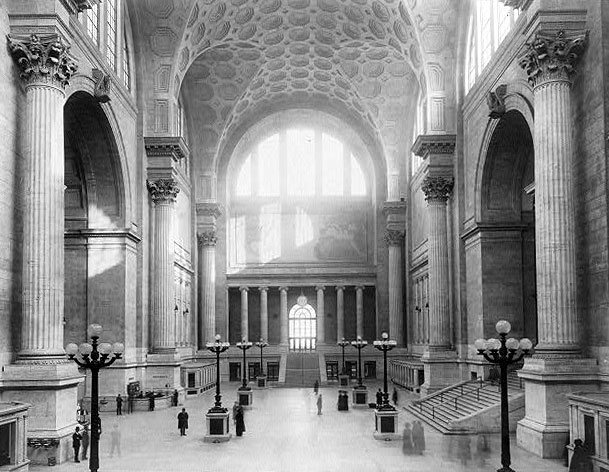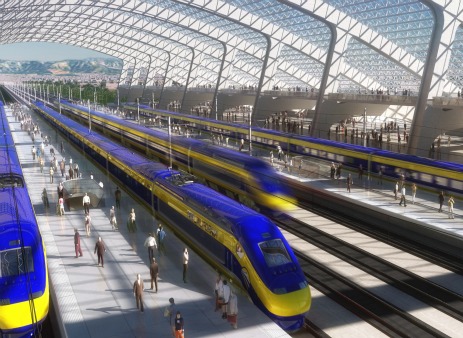 The saying goes that in Manhattan’s original Penn Station, pictured here in 1911 and demolished in the 1960s, you entered the city like a king; and in its low-slung, subterranean replacement, you enter like a rat. Photo: WikimediaAt his State of the Union address Tuesday night, President Obama offered an inspiring vision for U.S. transportation:
The saying goes that in Manhattan’s original Penn Station, pictured here in 1911 and demolished in the 1960s, you entered the city like a king; and in its low-slung, subterranean replacement, you enter like a rat. Photo: WikimediaAt his State of the Union address Tuesday night, President Obama offered an inspiring vision for U.S. transportation:
Within 25 years, our goal is to give 80 percent of Americans access to high-speed rail. This could allow you to go places in half the time it takes to travel by car. For some trips, it will be faster than flying — without the pat-down. As we speak, routes in California and the Midwest are already underway.
Secure · Tax deductible · Takes 45 SecondsSecure · Tax deductible · Takes 45 Seconds
Unfortunately, he undercut that vision a few minutes later with his vow to “freeze annual domestic spending for the next five years.” High-speed rail networks do not materialize with the snap of a finger or the uttering of words, no matter how inspiring. They cost money: public money. Sarah Goodyear has a good post on rail’s funding problem in an age of conservative fiscal hysteria.
But it isn’t just conservative intransigence. Obama’s own refusal to push for dramatically more funding could be devastating to high-speed U.S. rail. Let’s look at the California project the president referred to. According to Wired, building out a high-speed line linking San Francisco and L.A. would cost about $42 billion. By 2035, the project could be taking 41 million people out of cars and planes on that well-travelled corridor, and generating nearly $3 billion annually in revenue. So far, the federal government (under Obama’s stimulus plan) has committed $2.3 billion, and California voters coughed up another $10 billion by voting for a bond issue. So that’s $12.3 billion of the $42 billion necessary.
What about the rest? “The state is confident it will line up more federal funding and $12 billion in private investment,” Wired reports. Even if that optimistic scenario plays out, California’s high-speed rail network stands about 40 percent short of its necessary funding. As we speak, it’s a high-speed train to nowhere. And if the idea can’t take wing in California, it’s almost certainly doomed nationwide. Don’t sell your car.
All of this got me thinking about the late historian Tony Judt’s splendid, posthumously published essay in the Jan. 13 New York Review of Books, called “Bring Back the Rails!” Every bit of it is worth reading, especially in light of Obama’s soaring words and earth-bound actions on the topic.
Judt argues convincingly that after 170 years and multiple transportation revolutions, trains remain stubbornly central to the project of modern life:
Trains were already modern life incarnate by the 1840s — hence their appeal to “modernist” painters. They were still performing that role in the age of the great cross-country expresses of the 1890s. Nothing was more ultra-modern than the new, streamlined superliners that graced the neoexpressionist posters of the 1930s. Electrified tube trains were the idols of modernist poets after 1900, in the same way that the Japanese Shinkansen and the French TGV are the very icons of technological wizardry and high comfort at 190 mph today. Trains, it would seem, are perennially modern — even if they slip from sight for a while. Much the same applies to railway stations. The petrol “station” of the early trunk road is an object of nostalgic affection when depicted or remembered today, but it has been constantly replaced by functionally updated variations and in its original form survives only in nostalgic recall. Airports typically (and irritatingly) survive well past the onset of aesthetic or functional obsolescence; but no one would wish to preserve them for their own sake, much less suppose that an airport built in 1930 or even 1960 could be of use or interest today.
It’s worth reading his riff on the durability of old railway stations (when they haven’t succumbed, that is, to the wrecking ball, like Manhattan’s glorious original Penn Station):
But railway stations built a century or even a century and a half ago — Paris’s Gare de l’Est (1852), London’s Paddington Station (1854), Bombay’s Victoria Station (1887), Zurich’s Hauptbahnhof (1893) — not only appeal aesthetically and are increasingly objects of affection and admiration: they work. And more to the point, they work in ways fundamentally identical to the way they worked when they were first built. This is a testament to the quality of their design and construction, of course; but it also speaks to their perennial contemporaneity. They do not become “out of date.” They are not an adjunct to modern life, or part of it, or a byproduct of it. Stations, like the railway they punctuate, are integral to the modern world itself.
But the main takeaway of Judt’s essay is that trains — in stark contrast to cars and planes — are a public good that needs public funding. Trains serve an increasingly important public function, both environmentally and in terms of, yes, convenience, he argues:
The cost of oil — effectively stagnant from the 1950s through the 1990s (allowing for crisis-driven fluctuations) — is now steadily rising and unlikely ever to fall back to the level at which unrestricted car travel becomes economically viable again. The logic of the suburb, incontrovertible with oil [he means gasoline] at $1 a gallon, is thus placed in question. Air travel, unavoidable for long-haul journeys, is now inconvenient and expensive over medium distances: and in Western Europe and Japan the train is both a pleasanter and a faster alternative. The environmental advantages of the modern train are now very considerable, both technically and politically. An electrically powered rail system, like its companion light-rail or tram system within cities, can run on any convertible fuel source whether conventional or innovative, from nuclear power to solar power. For the foreseeable future this gives it a unique advantage over every other form of powered transportation.
But because of the high cost of building out and maintaining train networks, they require public support (as, of course, do cars, in the form of road maintanence, etc.). Judt writes:
The railways were and remain the necessary and natural accompaniment to the emergence of civil society. They are a collective project for individual benefit. They cannot exist without common accord (and, in recent times, common expenditure), and by design they offer a practical benefit to individual and collectivity alike. This is something the market cannot accomplish — except, on its own account of itself, by happy inadvertence. Railways were not always environmentally sensitive — though in overall pollution costs it is not clear that the steam engine did more harm than its internally combusted competitor — but they were and had to be socially responsive. That is one reason why they were not very profitable.
Judt goes on to assert that creating a robust and well-funded national train system is critical to the project of maintaining modern life as we know it. He writes:
If we throw away the railway stations and the lines leading to them — as we began to do in the 1950s and 1960s — we shall be throwing away our memory of how to live the confident civic life. … If we can
not spend our collective resources on trains and travel contentedly in them it is not because we have joined gated communities and need nothing but private cars to move between them. It will be because we have become gated individuals who don’t know how to share public space to common advantage. The implications of such a loss would far transcend the demise of one system of transport among others. It would mean we had done with modern life.
In other words, if we lose the will to revive our train system, we (to twist up Obama’s money phrase Tuesday night) … lose the future! And as if to tweak Obama’s fixation on “competition” in the speech, Judt adds that rising nations like India never had the resources to throw their transportation lot to the automobile — and thus don’t have as far to go in creating 21st century train systems.
A secure and prosperous future lies with trains. To “win” it means investing serious cash now, not wringing our hands over that false demon, the deficit.




